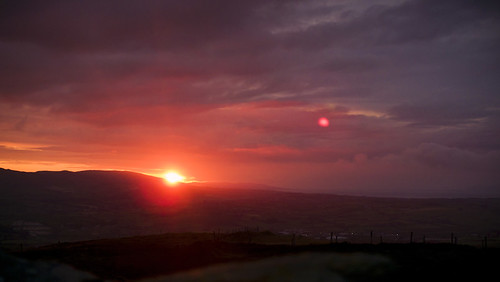Local Man Arthur O'Neill
I mentioned a while back that I’d recently found a new job. Well I haven’t lost it yet, I’m glad to report. It’s up at my local newspaper, where I’ve worked on and off over the years. I love where I live and I love being a journalist so it’s pretty much perfect really. Especially when you get stories like the one I wrote last week; the one where I found out that not only was King Arthur actually an honest-to-god real-life person, but he was from Inishowen! And there’s more - it turns out there’s even a chance I’m descended from him. You could be too! Seriously folks, the King Arthur.
Let me explain. According to new research by English historian Dane Pestano, Arthurian legend may very well have originated from a historical sixth-century High King of Ireland. Said king being Muircertach MacErca, who ruled from An Grianan and was the great-grandson of Niall of the Nine Hostages. For any of you not familiar with him, Niall was a legendary Ulster king who was apparently quite the ladies’ man. Genetic studies have found that around 20% of males in the north of Ireland and south-west Scotland carry his Y-chromosome and it’s believed up to six million people in the world today could be descended from him. As I said, he must’ve got around a bit.
Let me explain. According to new research by English historian Dane Pestano, Arthurian legend may very well have originated from a historical sixth-century High King of Ireland. Said king being Muircertach MacErca, who ruled from An Grianan and was the great-grandson of Niall of the Nine Hostages. For any of you not familiar with him, Niall was a legendary Ulster king who was apparently quite the ladies’ man. Genetic studies have found that around 20% of males in the north of Ireland and south-west Scotland carry his Y-chromosome and it’s believed up to six million people in the world today could be descended from him. As I said, he must’ve got around a bit.
An Grianan- the original Camelot?
That means there’s probably a fair chunk of the population round these parts who are related to MacErca too. Until recently not much was known about him, but a few years back Mr Pestano uncovered a lost tale in an old manuscript which led him on his Arthurian adventure. In his short book, Dane explains how the life MacErca, who also ruled from Grianan, almost exactly mirrors that of the man the Welsh and Britons knew as Arthur. Drawing upon both historical record and old folktales, here are just some of the links he identifies:
- MacErca was supposedly the first Christian king of Ireland and ruled at the same time as the mythical Arthur;
- His name can be translated as ‘Arthur’ and his wife’s name mirrors that of Gwenevere when translated into Welsh;
- As a child he was fostered by a driud;
- He conquered Gaul and assumed sovereignty of Britain, The Saxons, Scotland, The Orkneys, and Denmark;
- He was in possession of the Lia Fáil (the Stone of Destiny);
- There was a Merlin-type character, the bishop Cairneach, who guided him in his conquests and who could apparently perform magical feats;
- The idea of Morgan LeFey may also have originated here since there is one folktale which tells of a fairy woman who tried to seduce then murder MacErca;
- Finally, according to legend MacErca succumbed to the symbolic ‘triple death’.
MacErca was also the grandson of Eoghan, whom Inishowen is named after, and he was the uncle of another famous local lad, St Colmcille (aka St Columba), who had the gift of prophecy and was a bit of an Irish Nostradamus. I think the Glastonbury tourist board are going to have to review their brochures because if MacErca is indeed Arthur then his links to this area are incredible. When I was chatting to Dane on the phone about his work he said that Bettina over at Guarding Grianan Aileach may even have discovered the actual Round Table at the ring fort. How cool is that!
I think by now you lot know how much I love history and folklore, especially anything to do with Grianan, so you can imagine how excited I was about this story. I’m such a geek I was as thrilled working on it as someone else might’ve been if they’d gotten to interview their favourite actor or singer or something. Niall and Arthur are like celebrities to me :)
I think by now you lot know how much I love history and folklore, especially anything to do with Grianan, so you can imagine how excited I was about this story. I’m such a geek I was as thrilled working on it as someone else might’ve been if they’d gotten to interview their favourite actor or singer or something. Niall and Arthur are like celebrities to me :)
I think everyone at the paper thinks I’m a wee bit loopy for getting so excited about it, but I’m not just saying this - I think it’s the most fun I’ve ever had writing a story. I even discovered a new favourite word, toppling ‘troglodyte’ from it’s long-held first place spot. It’s ‘Galfridian’, as in ‘pre-Galfridian’ meaning ‘existing before Geoffrey of Monmouth wrote his famous twelfth century work on Arthur’. Nice, isn’t it? The stories about MacErca are pre-Galfridian.
Dane’s introductory book, ‘King Arthur in Irish Pseudo-Historical Tradition’, is available to download or order here. It’ll soon be on Amazon etc too and I’ll add those links as soon as I get them. He plans to publish a full edition next year so watch this space.
Dane’s introductory book, ‘King Arthur in Irish Pseudo-Historical Tradition’, is available to download or order here. It’ll soon be on Amazon etc too and I’ll add those links as soon as I get them. He plans to publish a full edition next year so watch this space.











































